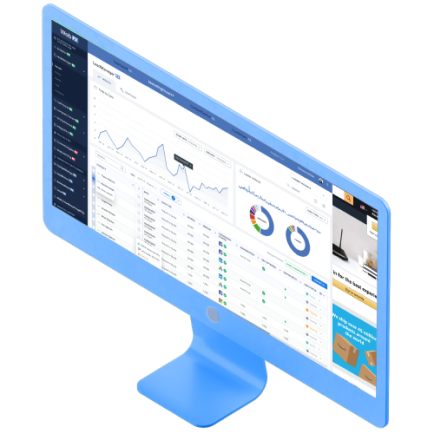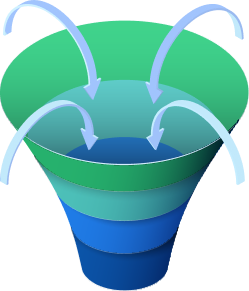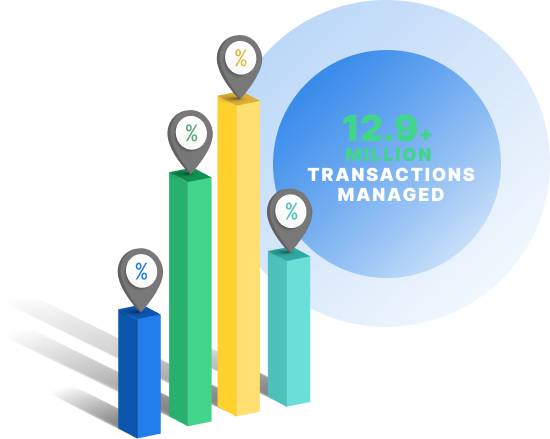-
 Published: Jun 2, 2023
Published: Jun 2, 2023
-
 11 min. read
11 min. read
-
 Sina Mchunu
Sina Mchunu Research & Tech Content Writer
Research & Tech Content Writer
- Sina is a marketing expert who specializes in SEO, AI, and digital marketing content. With over five years of experience, she’s written hundreds of pieces, spanning a variety of topics and industry niches. She loves combining her strong eye for detail and passion for storytelling in her work. You’ll find her fruit picking or horse riding at the local farm when she’s not writing.
Are you noticing a leak in your sales pipeline? Maybe you’ve recently realized that you’re not generating enough leads or that your conversion rates are lower than you’d hoped. This post is for you if you want to learn how to pinpoint the roots of your sales pipeline challenges and implement solutions before they affect your company’s bottom line and growth prospects.
We’ve been in operation for over 25+ years, and the flow of leads and income hasn’t always been consistent. While we can appreciate the disappointment of falling short of goals, we believe every failure presents an opportunity for growth.
We learned from past mistakes that taking precautions ahead of time may prevent problems and guarantee lasting success. That’s why we compiled the following five sales pipeline issues with solutions to help you succeed in achieving your goals:
- Poor pipeline visibility
- Pipeline imbalance
- Pipeline leakage
- Pipeline stagnation
- Pipeline optimization
You can use this checklist to pinpoint problems in your sales pipeline and devise solutions. Let’s get right on it!
Don’t miss our Marketing Manager Insider emails!
Join 200,000 smart marketers and get the month’s hottest marketing news and insights delivered straight to your inbox!
Enter your email below:
Inline Subscription Form – CTA 72
“*” indicates required fields
(Don’t worry, we’ll never share your information!)

1. Poor pipeline visibility
The first challenge on our list is poor pipeline visibility. A lack of leads makes it impossible to monitor deals, determine the status of leads, and make reliable projections.
Poor pipeline visibility makes it difficult for your sales teams to see the full scope of the opportunities available, making it tough to spot potential issues and leading to lost sales and inaccurate projections. Without this information, salespeople have no idea which deals have the best chance of closing, which require more work, and which have stalled.
What causes poor pipeline visibility?
Several factors can interfere with pipeline visibility, including the following:
- Poor data quality: A lack of complete or accurate data can make evaluating the health of deals in the pipeline difficult, which can cause incorrect assessments and delayed decisions.
- Lack of standardized processes: Maximizing performance and finding growth opportunities is difficult without standardized systems to ensure continuous tracking of transactions and sales team success. Thus, causing the sales process to be chaotic and inefficient.
- Inadequate reporting tools: Inadequate reporting tools can further compound the problem by limiting key metrics visibility and hindering the ability to make data-driven decisions, resulting in missed opportunities and suboptimal outcomes for the sales team and the organization.
- Inconsistent processes across teams: Lack of consistency in procedures across teams is a major cause of inefficiency and poor collaboration, which can cause a lack of alignment and even competing goals.
What’s the solution?
With the correct systems in place, your organization can overcome this challenge and provide clear visibility into its pipeline for all employees. You can do this by:
- Introducing a customer relationship management (CRM) system — like Nutshell — that automatically updates you on the progress of your deals and makes it simple to monitor and analyze your pipeline data
- Investing in sales enablement technology like MarketingCloudFX to keep tabs on sales figures, evaluate them for weak spots, and make decisions based on hard numbers to boost profits
- Implementing standardized sales processes to keep your team organized and productive, ensuring they retain all leads and look into all prospects
- Facilitating open lines of communication between sales representatives and managers to increase productivity and effectiveness and reduce decision-making timelines
Ultimately, improving pipeline visibility is crucial to achieving sales success and maximizing revenue potential.
Meet MarketingCloudFX:
One platform tracking countless metrics and driving stellar results.
Learn More About Our Proprietary Software

2. Pipeline imbalance
Next on our list of sales pipeline challenges is pipeline imbalance. This challenge occurs when there is an uneven distribution of leads or opportunities throughout the pipeline, overloading some stages while others are empty.
This imbalance causes a bottleneck effect, slowing the sales process and making it difficult to forecast revenue accurately. It’s important for sales teams to regularly review and adjust their pipeline to ensure a balanced flow of leads and opportunities.
Pipeline imbalance can significantly impact revenue generation as it creates an unpredictable flow of deals, making forecasting difficult. Sales teams may miss out on potential opportunities due to delayed or lost deals, decreasing revenue.
What causes pipeline imbalance?
Pipeline imbalances occur for several reasons, including:
- Poor lead management and inadequate qualification criteria: Leads can get stuck in the pipeline at certain stages if they are not correctly categorized and prioritized. In addition, a bottleneck effect can occur if sales representatives are not adequately trained to identify and eliminate low-quality leads.
- Inconsistent follow-up: Leads can get lost in the pipeline if sales reps don’t consistently follow up with them.
- Inefficient sales process: Not optimizing the sales process for efficiency can lead to pipeline delays and inconsistencies.
- Insufficient resources to manage leads: Not allocating enough resources to manage leads at various pipeline stages can cause a roadblock and an unbalanced flow of leads. Inadequate resources — lack of salespeople to handle incoming leads or an absence of suitable software — can prevent your company from making the most of its pipeline.
- Market or economic factors: Pipeline inequities can also be brought on by external factors like market or industry shifts. Regularly evaluating and adjusting your sales pipeline is crucial to maintaining a healthy sales process.
What’s the solution?
You can only get past this roadblock by locating its origin and nullifying it. Maintaining a constant flow of leads and opportunities requires routine assessment and adjustment of sales strategies. These can include:
- Targeted marketing campaigns: Use data-driven insights to identify your ideal customer profile and tailor your marketing efforts to reach them specifically.
- Lead scoring: Implement a lead scoring system to prioritize high-quality leads, streamline the sales process, and increase efficiency.
- Lead nurturing programs: Create a plan to nurture and move leads through the sales funnel. This plan can involve personalized communication, providing valuable content, and addressing any concerns or objections they may have.
- Lead qualification processes: Implement effective lead qualification processes to ensure your team focuses on the most promising leads, saving time and resources. This process can include assessing budget, authority, need, and timeline to determine which leads will most likely convert into customers.
It’s also crucial to clearly understand your target audience and their buying behavior, so you can tailor your sales approach accordingly and ensure a balanced pipeline. Addressing pipeline imbalance can increase your chances of closing more deals and achieving your sales goals.
3. Pipeline leakage
Leakage in the sales pipeline occurs at any point where leads are lost or abandoned before becoming clients. Because it directly affects sales and expansion, pipeline leakage can significantly affect your company.
When leads are lost, the potential for new customers decreases, resulting in missed opportunities. This loss can also lead to reduced customer loyalty and brand reputation. Maintaining a robust and balanced pipeline necessitates a strong emphasis on lead nurturing, efficient lead qualification procedures, and a thorough comprehension of target audience behavior.
What causes pipeline leakage?
Pipeline leakage can happen for various reasons, such as:
- Lack of follow-up or communication: This can lead to potential leads losing interest or seeking solutions elsewhere, ultimately damaging the company’s credibility in the market.
- Poor sales techniques or inadequate product knowledge: This issue can also contribute to pipeline leakage and negatively impact a company’s reputation.
- Mismatch between the lead’s needs and your product or service: If your product or service does not align with the needs of your potential leads, they are less likely to convert into customers, resulting in lost opportunities and decreased customer loyalty. Understanding your target audience and their needs is crucial to preventing pipeline leakage.
- Failure to address concerns or objections: The pipeline might leak when potential consumers voice worries or complaints, and you don’t properly address them. If their requirements aren’t satisfied, they may look elsewhere for help, costing you prospective sales.
What’s the solution?
Identifying and addressing pipeline leakage is crucial for maintaining a healthy sales pipeline and maximizing conversion rates. This can involve:
- Analyzing your sales data to identify patterns and areas for improvement
- Improving your sales messaging or offering additional resources to address customer concerns.
- Implementing targeted strategies to address common issues
- Continuously monitoring and optimizing your sales process to ensure maximum efficiency and effectiveness.
By focusing on lead qualification and pipeline management, you can minimize pipeline leakage and increase the likelihood of closing more deals and achieving your sales targets.
A hole in your marketing funnel will drain your sales.
Learn how to patch it with our free tool.
Fix Your Marketing Funnel

4. Pipeline stagnation
Pipeline stagnation is a common problem when pipeline leakage is not dealt with, and there’s insufficient movement or progress in the pipeline.
By staying on top of pipeline leakage and addressing any issues, you can avoid pipeline stagnation and keep your pipeline moving, increasing the likelihood of closing more deals and achieving your targets.
What causes pipeline stagnation?
Various factors can hamper a pipeline’s flow, such as:
- Lackluster dialogue during sales: If you can’t persuade your target market of the worth of your product or service, sales may stall, and you’ll lose money.
- Lack of follow-up: We can’t stress this enough — leads will stagnate in your pipeline if you don’t actively follow up with them, as they may lose interest or forget about your product or service.
- Lack of automation: Pipelines can stall out and become unproductive if you don’t automate routine tasks like sending follow-up emails to leads or scheduling appointments.
- Poor lead qualification: Lack of proper lead qualification can cause your pipeline to become clogged with less promising leads because you’re chasing after people who don’t fit your ideal customer profile.
- Inadequate resources to resolve customer issues: Understaffed or underfunded customer service departments can cause customers to lose faith in your business and ultimately stop buying from you.
What’s the solution?
The key to resolving pipeline stagnation is identifying the specific points of friction between your sales process and your leads. Some possible solutions to pipeline stagnation include:
- Improving sales messaging: Craft clear and compelling sales messages that resonate with your target audience and help move leads through the pipeline.
- Automating repetitive tasks: Automate routine tasks such as lead follow-up emails or appointment scheduling to streamline the process and reduce the risk of pipeline stagnation.
- Qualifying leads carefully: Spend time identifying your ideal customer profile and qualifying leads based on those characteristics to ensure that valuable resources are well-spent on productive clients.
- Investing in customer support: Make sure you have enough people and tools on hand to handle any issues that arise and keep customers happy, which can increase engagement and stimulate pipeline activity.
Lead qualification and pipeline management are crucial for minimizing pipeline leakage and avoiding stagnation. You can optimize your sales process and speed up the progression of leads through the pipeline by identifying and removing any bottlenecks you find along the way.
5. Pipeline optimization
Pipeline optimization is an ongoing process that requires constant monitoring and adjustment. Regularly reviewing your sales metrics and analyzing your pipeline data can help you identify areas for improvement and make necessary changes to keep your pipeline flowing smoothly.
You can increase your chances of closing more deals and achieving your sales goals by continually optimizing your pipeline.
What are the signs that your pipeline requires optimization?
There are several indicators that suggest your pipeline needs optimization. These include the following:
- High number of stalled deals: It might be time to reevaluate your sales process and locate any bottlenecks if you see that a significant portion of your deals is becoming stuck at the same stage in your pipeline. This warning sign might indicate failure to follow up with prospects or ineffective communication.
- Long sales cycle: If your sales cycle is longer than you had anticipated, it might be worthwhile to look over your sales process to find places where you can simplify and accelerate it. Doing so might entail enhancing lead qualification, giving prospects information that is more focused and pertinent, or finding ways to hasten the decision-making process.
- Low conversion rates: Reevaluating your sales strategy might be necessary if you are seeing low conversion rates. To encourage prospects to act, you can reassess your target market, change your messaging, or provide incentives.
What’s the solution?
You could enhance your sales process, reduce losses, and increase revenue by analyzing and correcting these key performance indicators. Pipeline optimization involves analyzing and adjusting your sales metrics, such as:
- Conversion rates: The rate at which leads move through the pipeline and convert into paying customers.
- Sales cycle length: The time it takes for a lead to move from initial contact to conversion.
- Lead velocity: How quickly leads are moving through the pipeline.
- Pipeline stage velocity: How quickly leads are moving through each pipeline stage.
If you implement a CRM system, you can track your leads’ progress through the sales pipeline and anticipate any potential problems they may encounter.
Constant monitoring and tweaking of the sales process is necessary to maintain the pipeline filled and active, generate more money, and make the company more successful.
Time to Level Up Your Sales
Our long list of services helps you grow every aspect of your business with marketing strategies that are proven to increase bottom-line metrics like revenue and conversions.
In the past 5 years, we’ve managed more than 14.9 MILLION transactions across our client base.

Fix the cracks in your pipeline with conversion rate optimization (CRO) services
Don’t let leaks in your pipeline go unchecked. At WebFX, we offer CRO services to help you identify weak spots in your sales pipeline and increase the likelihood of converting visitors into customers.
Our experts will analyze user behavior, conduct A/B testing, and implement strategic changes to improve your bottom line significantly.
Plus, our revenue-accelerating software, MarketingCloudFX and Nutshell Marketing, gives you access to potent tools that streamline your sales process and provide valuable insights into the needs and preferences of your customers, empowering you to make decisions based on hard data that boost your company’s growth and bottom line.
Ready to see a 20% increase in sales and revenue?
Contact us online or call 888-601-5359 to speak with a strategist about how we can help keep your business flowing smoothly.
-
 Sina is a marketing expert who specializes in SEO, AI, and digital marketing content. With over five years of experience, she’s written hundreds of pieces, spanning a variety of topics and industry niches. She loves combining her strong eye for detail and passion for storytelling in her work. You’ll find her fruit picking or horse riding at the local farm when she’s not writing.
Sina is a marketing expert who specializes in SEO, AI, and digital marketing content. With over five years of experience, she’s written hundreds of pieces, spanning a variety of topics and industry niches. She loves combining her strong eye for detail and passion for storytelling in her work. You’ll find her fruit picking or horse riding at the local farm when she’s not writing. -

WebFX is a full-service marketing agency with 1,100+ client reviews and a 4.9-star rating on Clutch! Find out how our expert team and revenue-accelerating tech can drive results for you! Learn more
Try our free Marketing Calculator
Craft a tailored online marketing strategy! Utilize our free Internet marketing calculator for a custom plan based on your location, reach, timeframe, and budget.
Plan Your Marketing Budget

Maximize Your Marketing ROI
Claim your free eBook packed with proven strategies to boost your marketing efforts.
Get the GuideTry our free Marketing Calculator
Craft a tailored online marketing strategy! Utilize our free Internet marketing calculator for a custom plan based on your location, reach, timeframe, and budget.
Plan Your Marketing Budget





